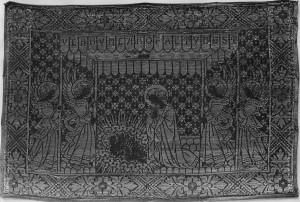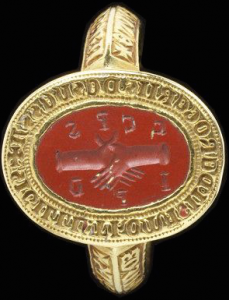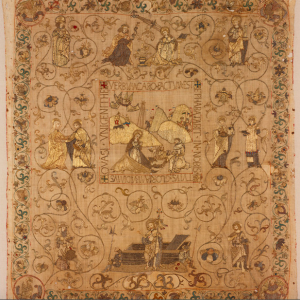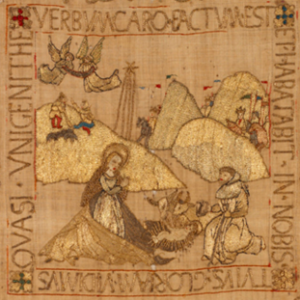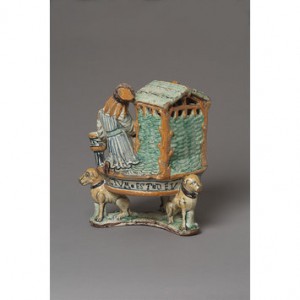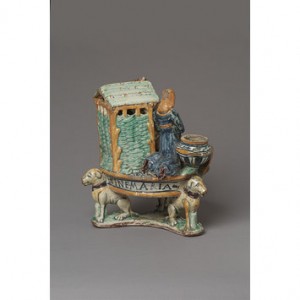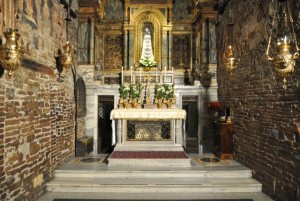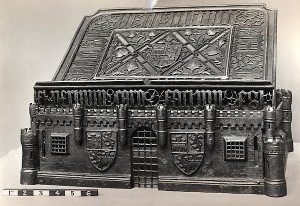 This intimidating piece of metalwork is an iron lectern from the late nineteenth or early twentieth century, although you would be forgiven for thinking it was five centuries older. An imposing fortress ornamented with shields supports the book-rest, on which the opening of John’s gospel is cast in relief: ‘IN PRINCIPIO VERBUM’. John 1:14 appears around the base of the book-rest, above the battlements: ‘ET VERBUM CARO FACTUM EST’. The other church furnishings in this very eclectic exhibition have been associated with the altar, and the sacrament of the Mass. Here, however, the words from John are integral to a piece of ‘book furniture’, and the reminder that ‘the Word was made flesh’ underlines the words read from any book opened on this lectern.
This intimidating piece of metalwork is an iron lectern from the late nineteenth or early twentieth century, although you would be forgiven for thinking it was five centuries older. An imposing fortress ornamented with shields supports the book-rest, on which the opening of John’s gospel is cast in relief: ‘IN PRINCIPIO VERBUM’. John 1:14 appears around the base of the book-rest, above the battlements: ‘ET VERBUM CARO FACTUM EST’. The other church furnishings in this very eclectic exhibition have been associated with the altar, and the sacrament of the Mass. Here, however, the words from John are integral to a piece of ‘book furniture’, and the reminder that ‘the Word was made flesh’ underlines the words read from any book opened on this lectern.
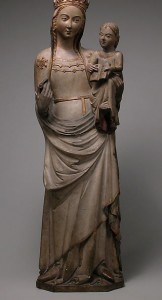
This Catalan image of the Virgin and Child was carved from limestone in the middle of the fourteenth century, and still bears traces of polychromy and gilding. The infant Christ holds a book with both hands, and points us to the words visible on the open pages: ‘VERBO/CARO’ (left page); ‘FACTUM/EST.ET/ABIT/UIT M/’ (right page). Standing at just under life-size (132.7 cm tall), this statue offers a strikingly elegant exposition of John’s words, especially the end of the verse: through the Incarnation, Mary brought Christ ‘among us’.
Metropolitan Museum of Art; bequest of George Blumenthal, 1941
Accession Number: 41.190.282
Image: Metropolitan Museum of Art
This small round container (8.2 cm in diameter) is a silver pyx, used to protect and transport the Blessed Sacrament. Made in England at the turn of the seventeenth century, its history is uncertain; it may have been associated with recusant Catholicism in post-Reformation England. The words ‘VERBUM CARO FACTUM’ are engraved around the edge on the front of the pyx. Visible through the glazed panel, the consecrated Hosts would have been framed by these words, and venerated by the two tiny angels above. On the reverse of the pyx, Christ on the cross is framed by Moses and the serpent, and Abraham and Isaac – two Old Testament prefigurations of the Crucifixion. There are also further Latin inscriptions: ‘FILIVS IMMOLATUS DATVR CIBVS VIATORIBVS’ (‘The son who was sacrificed is given as food to travellers’) and ‘+ HÆC EST MENSA DOMINI NOBIS DE CÆLO PARATA ADVERSVS OMNES QUI TRIBVLANT NOS’ (This is the table of our Lord prepared for us from Heaven against all those who bring us tribulation’). Through this object, the Word made flesh becomes a portable source of nourishment to be consumed anywhere, not just at the altar.
Victoria and Albert Museum
Museum no. M.18-2012
Image: Victoria and Albert Museum
This woven silk panel (36.2 x 55.2 cm; see link for better image) is from Florence or Siena, made in the late fifteenth or early sixteenth century. It would have been part of a liturgical vestment worn by one of the sacred ministers in church. Under a canopy borne by four angels, the Virgin Mary kneels before her baby. The letters ‘VERBUM CARO FACTUM EST’ appear on the panels of the canopy; a scriptural annotation literally interwoven into the scene. God took on human flesh in the infant Christ, this image tells us, but it is also symbolic of the Eucharist: a canopy such as this would be used in liturgical processions, to protect and honour the Blessed Sacrament. The stylised representation of the manger with its radiant beams is reminiscent of a monstrance, with which the sacramental presence would be displayed on the altar or in processions and before which the faithful would kneel in adoration, in imitation of the Virgin Mary here.
Metropolitan Museum of Art; Fletcher Fund, 1946
Accession Number: 46.156.96
Image: Metropolitan Museum of Art
Katherine Tycz is a PhD candidate in the Italian Department at the University of Cambridge and a member of the research project funded by the European Research Council, Domestic Devotions the Place of Piety in the Renaissance Italian Home, 1400-1600. Her doctoral research considers the efficacy and materiality of text in early modern Italian devotional practices, and she writes here about an Italian signet ring.
Italian Signet Ring; Victoria & Albert Museum M.275-1962
Stone, 3rd century AD; Ring, 14th century AD
Engraved gold and red jasper stone
An ancient intaglio gem, engraved with clasped hands and the letters ‘CCPS’ and ‘IPD’, found a new life in the fourteenth century when a priest called Tommaso de Rogerii repurposed it to serve as his personal seal. The symbol of intertwined hands represented an agreement that had been sealed by a handshake, and thus also acquired connections with vows—whether made in lay marriages or in agreement to religious life. Not only etched in stone, but also appearing on rings moulded out of metal, this symbol remained popular throughout the early modern period across Europe. Eventually the rings became known by collectors as fede rings, after the Italian term for the clasped-hands symbol (mani in fede), reflecting their representation of a faithful agreement or alliance.
Embedded in a rich gold ring, the gem’s image would be pressed in molten wax, revealing the reverse of the image, to seal important documents from the desk of the priest. Arranged around the edge of the gem, another inscription identified Tommaso as the ring’s owner: ‘SIGILLU. THOMASII.DE. ROGERII S.DESUESSA [The seal of Tommaso de Rogerii, priest of Suessa]’. Allegedly found in the church of Santa Maria in Commedia in Sessa [Suessa] Aurunca, a hamlet near Naples, in the mid-nineteenth century, this ring may have been used by the church’s priests as a signet ring throughout the centuries. Or perhaps it was left in the church as a votive offering by Tommaso.
Other inscriptions reveal other facets of the ring’s function; embossed around the band in parallel rows are the words, ‘+ ET VERBU: CARO. FACTU: E:ET ABITANT:/ NOB [and the word was made Flesh and he dwelt among us]’ and ‘/+ XPS VINCIT X XPS X REGNAT X XPS: IMPERA [Christ conquers, Christ reigns, Christ rules]’.
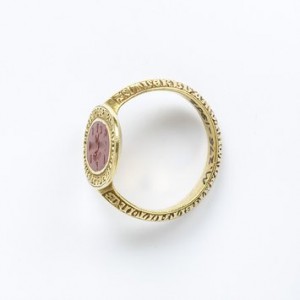 A longer excerpt from the Gospel of John [‘Verbum caro factum est’] has been inscribed on this ring. Not only is the moment of the incarnation of the Word captured here, but also the continuing presence of God’s Word on Earth through Jesus. The paired inscription, ‘Christ conquers, Christ reigns, Christ rules’, further explains the omnipotent role of Christ in Christian belief. Taken literally, both inscriptions reflect the Christian identity of the ring’s owner. Further, the use of the Verbum caro citation on a tool utilised in the act of writing and sealing is particularly evocative.
A longer excerpt from the Gospel of John [‘Verbum caro factum est’] has been inscribed on this ring. Not only is the moment of the incarnation of the Word captured here, but also the continuing presence of God’s Word on Earth through Jesus. The paired inscription, ‘Christ conquers, Christ reigns, Christ rules’, further explains the omnipotent role of Christ in Christian belief. Taken literally, both inscriptions reflect the Christian identity of the ring’s owner. Further, the use of the Verbum caro citation on a tool utilised in the act of writing and sealing is particularly evocative.
However, these two phrases also hold other, more occult meanings. Individually, each phrase holds amuletic power. Both expressions were employed for protective purposes on a variety of objects throughout Europe, and were especially common on wearable amulets, such as rings, pendants, and also a type of parchment or paper prayer sheet that would be sealed in a pouch and worn on the body. The red jasper stone, a type that had long been used for protective and curative purposes, also gained power from its ancient origins. In combination with the jasper, the efficacy of these religious and apotropaic inscriptions would be enhanced for the ring’s wearer.
Images: Victoria & Albert Museum
Alison Knight, Postdoctoral Research Fellow on the Bible and Antiquity in 19th-Century Culture project at the University of Cambridge, writes here about a seventeenth-century sermon on this verse.
On December 25, 1611, Lancelot Andrewes preached a sermon on John 1:14 to James I at Whitehall. He opens with a surprising comparison: the verse is, to Andrewes, like an eagle’s flight. Just as St John is the eagle of the four evangelists, and just as John’s gospel is, like the eagle, “wonderfully high,” this verse inscribes the mystery of incarnation in John’s characteristically aquiline manner. Andrewes explains that
the nature of the Eagle is, by GOD himselfe, described (Iob 39.) by two properties, elevari ad ardua, no foule vnder heaven towreth so high: and vbicunque fuerit cadaver statim adest; None so soone or so sodainly downe vpon the bodie, as he. Both these do lively expresse themselues in Saint Iohn…as an Eagle in the clouds, he first mounteth wonderfully high, beyond MOSES and his In principio, with an higher In principio then it; beyond Genesis and the worlds Creation: That the Word was then with GOD and was GOD. This may well be termed the Eagles flight; so exceedingly high, as the cleerest eye hath much adoe, to follow him. Yet, so farr as they can follow him, the very Philosophers have been driven, to admire the penning of this Gospell. But after this, as an Eagle againe…downe he commeth directly, from the height of heaven, and lights vpon the body of His flesh, the mysterie of His incarnation
(XCVI Sermons (London, 1629), p. 44)
The swift movement of John’s language, with its dizzying expression of complex incarnation theology within so few words, becomes for Andrewes like the blinding flash of an eagle’s dive to earth. As his sermon progresses, he attempts to arrest that flight, teasing out the theological distinctions inscribed in the verse in characteristic Andrewes fashion. We see his punning wordplay as he argues against heretical Manichean, Cerinthian, Valentinian, and Nestorian interpretations of the verse (“Manicheus holding that he had noe true body: as if, factum had been fictum, or making were mocking”); as the sermon draws to a close, he makes a typical association between this verse’s incarnational verbum caro factum est and the hoc est corpus meum of the Eucharist; and throughout, the manifold meaning inscribed in the words word, made, flesh are scrutinised from every angle. Andrewes’s striking simile, that this scriptural verse is like an eagle’s flight, is not revisited, but through it he represents scripture and “the Word made flesh” as an active, moving textual force.
On this late fifteenth-century embroidered altarpiece from Germany, the inscription from John 1:14 frames a central scene, showing the Nativity. Beyond this textual frame, the embroidery depicts other moments from the life of Christ, including the Annunciation and the Resurrection. But the focus of this covering for the sacramental site of the altar is the moment at which Christ came into the world, first witnessed by the shepherds, to whom you can see angels bringing the news on the rocky hills in the background.
Unknown artist, Germany; Colmar
Embroidered altarpiece, late 15th century
Linen; silk; metallic yarn
Length: 88.9 cm (35 inches)
Helen M. Danforth Acquisition Fund and Mary B. Jackson Fund 1992.041
Images: RISD Museum
Katherine Tycz, a PhD candidate in the Italian Department at the University of Cambridge and a member of the research project funded by the European Research Council, Domestic Devotions: The Place of Piety in the Renaissance Italian Home, 1400-1600 writes here about a sixteenth-century inkstand from Tuscany.
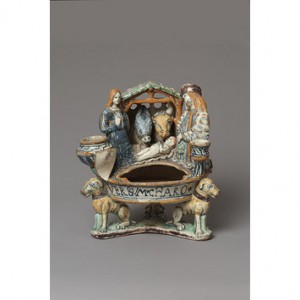 Nativity Inkstand; maiolica (tin-glazed earthenware); Tuscany, c. 1510
Nativity Inkstand; maiolica (tin-glazed earthenware); Tuscany, c. 1510
Victoria & Albert Museum 396-1889; images courtesy of the V&A.
‘VERBVM*CHARO*FACTUM*EST*DE VIGINE*MARIA*’—the words emblazoned in blue around the base of this ceramic Nativity inkstand declare the message that ‘Through the Virgin Mary, the Word became flesh’. The famous words from the Gospel of John (‘Verbum caro factum est’), have been expanded in this inscription to reflect the Virgin’s central role in the incarnation of Word of God. This inkstand captures a peaceful familial scene soon after the momentous realisation of this incarnation.
Perched atop a basin supported by three canines, Mary and Joseph, dressed in contemporary Renaissance garb, look adoringly upon their newborn son. The Christ Child sleeps in the manger inhabited by an ox and a donkey. While ‘Verbum caro’ originates in the Gospel of John, this Gospel (along with Mark) makes no mention of the Nativity story. In fact, it is believed that the arrangement of this Nativity does not originate from the two Gospels that narrate the Nativity (Matthew and Luke), but instead derives from one of the apocryphal gospels—the Pseudo-Matthew—which mentions the ox and the donkey’s adoration in the manger.
Meant to hold various writing accoutrements (quills, ink, sand, pounces), the miniature vases next to Mary and Joseph were decorated to reflect contemporary maiolica styles. Leaning upon the larger of the two vessels is a blank shield. Shields such as this would have been painted with the owner’s arms. The blank armorial shield on this inkstand reveals much about the manufacturing process of these objects; as is demonstrated by the number of similar extant examples, they were produced in a substantial quantity and would be personalized upon purchase. Evidence also exists that such inkstands may have been offered as gifts to a future bride during the process of marriage agreements. [1]
Figural maiolica inkstands reached a height of popularity around the turn of the sixteenth century. Displaying both secular and devotional subjects, they served a practical as well as a decorative use. To read the full ‘‘VERBVM*CHARO*FACTUM*EST*DE VIGINE*MARIA*’ message, the inkstand would need to be turned. The physical interaction of touching the object while viewing its inscription and scene, and perhaps even reciting the words aloud, could enhance the devotional experience of this object. These inkstands may have been used solely by the bride for whom they were commissioned, or perhaps by other members of the household, even later serving as instructional tools during the schooling of the couple’s children. Inscribed like this with an evocative phrase from a sacred text accompanying a narrative scene, this inkstand served multiple purposes in a Renaissance home; it was not only a functional and decorative, but could also be used for didactic and devotional purposes.
For an object meant to facilitate the act of writing, the ‘Verbum caro factum est’ citation is apt. When the writer utilised the inkstand to convert words from their minds into a writing on a page, he/she could meditate upon the belief that through the Nativity of Christ, God’s Word became flesh. According to Christian belief, clay became man in the Old Testament, and with the advent of the New Testament, the Word became Flesh; here, these concepts intertwine as clay has been transformed to represent the Word becoming flesh.
[1] ‘Nativity Inkstand’, Victoria & Albert Museum 396-1889 http://collections.vam.ac.uk/item/O129396/inkstand-unknown/. See also Marta Ajmar-Wollheim and Flora Dennis, At Home in Renaissance Italy (London, V&A Publications 2006), pp. 107-108.
A Lytyll compilacion declaryng when men kysse in Churche stoone or erthe Tymbre or Iron. What they shuld remembre therby.
O deuout pepyll whyche kepe an obseruaunce
Lowly in churche to kysse stoone or tre,
Erthe or yron, haue in remembraunce
What they do meane, take the moralyte;
Erthe tokeneth furst the pure humanyte
Of Cryst Iesu, the stone hys sepulture,
The spere of steele, the sharpe nayles thre,
Made large his woundes, remembryd in scripture.
Thynke on the crosse, made of four dyuerse trees.
As Clerkes seyn, of Cedyr and Cypresse,
To hygh estates and folkes of lowe degrees
Cryst brought in pease, the Olyfe bereth wytnesse;
The Cedre aloft, contemplatyf swetnesse,
Graue all these sygnes depe in thy memory,
And howe hys passion was groundyd on mekenesse,
Geyne cruell Sathan to make vs haue vyctory.
These .iiij. fygures combynyd into oon,
Put in thy mynde for a memoryall,
Erthe and yron, iiij trees and the stoon,
To make vs fre where as we were thrall,
Beholde the baner vyctoryous and royall,
Crystes crosse as standard of most pryse,
Thynke howe the thyef for mercy dyd call,
Tawght by thys tre the way to paradyse.
Your hertes ey lyft vp in-to the Est,
All yowre body and knees boweth downe,
When the preest seyth Verbum caro factum est,
With all your inward contemplacion,
Your mowthe furst crossyd of hygh deuocion,
Kyssyng the tokenes rehersyd here toforn,
And euer haue mynde on Crystes passion
Whyche for your sake weryd a crowne of thorne.
John Lydgate (c. 1370-1451)
Irene Galandra Cooper is a PhD student at the Faculty of History, University of Cambridge, and a member of the research project funded by the European Research Council, Domestic Devotions the Place of Piety in the Renaissance Italian Home, 1400-1600. She writes here about the shrines of the Annunciation at Nazareth and Loreto.
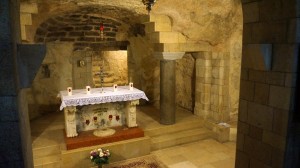 Grotto of the Annunciation, Nazareth
Grotto of the Annunciation, Nazareth
In Nazareth, the Lower Basilica of the Church of the Annunciation hosts the holy site of the ‘grotto of the Virgin’ – believed to be the place where the Angel appeared to Mary and announced that she was to become the Mother of God. The altar in the grotto bears a Latin inscription: Verbum caro hic factum est. These words include a significant addition to the phrase from the Gospel of John: hic, or ‘here’.
When pilgrims to Nazareth read the inscription as they meditate on the miracle of the Incarnation, they stand where it all began: hic is a powerful, unique, site-indicator. Of Mary’s little house, however, only hewed rock remains. According to a late thirteenth-century legend, the rest of the bricks were miraculously transported from the Holy Land by angels to protect it after the Muslim defeat of the Crusaders. The house settled first in Dalmatia and then, in 1294, came to rest at Loreto, a hilltop town near Ancona, on the Adriatic coast of Italy.
In Loreto, as in Nazareth, a multitude of devotees come to kneel in front of the medieval altar built within the little room, which bears the same Latin inscription: Hic Verbum caro factum est. Now moved to a prime position at the beginning of the phrase, hic is more emphatic, drawing the faithful into an even stronger bond with the place where the words are read, and in turn, with the place where the Word became flesh.
The apparently contradictory existence of two places where the Word was made flesh may remind the faithful of what follows in the rest of the verse: Verbum caro factum est, et habitavit in nobis – the Word is always ‘here’, because as flesh God ‘dwelt amongst us’.

